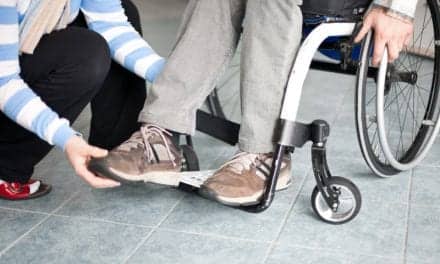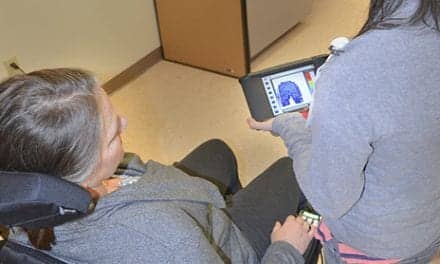10-03-2006
A multi-institutional team of researchers has found that people with long-standing, severe paralysis can generate signals in the area of the brain responsible for voluntary movement and these signals can be detected, recorded, and routed out of the brain to a computer and converted into actions—enabling a paralyzed patient to perform basic tasks.
In the July 13, 2006, issue of Nature, the researchers present the first published results from the initial participants in a clinical trial of the BrainGate Neural Interface System, a “neuromotor prosthesis” developed by Cyberkinetics Neurotechnology Systems Inc, of Foxborough, Mass.
The first patient, Matthew Nagle, a 25-year-old Massachusetts man with severe spinal cord injury, has been paralyzed from the neck down since 2001. After having the BrainGate sensor implanted on the surface of his brain at Rhode Island Hospital in June 2004, he learned to control a computer cursor simply by thinking about moving it.
During 57 sessions, from July 2004 to April 2005, at New England Sinai Hospital and Rehabilitation Center, Nagle learned to open simulated e-mail, draw circular shapes using a paint program on the computer, and play a simple video game—”neural Pong”—using only his thoughts. He could change the channel and adjust the volume on a television, even while conversing. He was ultimately able to open and close the fingers of a prosthetic hand and use a robotic limb to grasp and move objects. Despite a decline in neural signals after 6 and a half months, Nagle remained an active participant in the trial and continued to aid the clinical team in producing valuable feedback concerning the BrainGate technology.
The second patient, a 55-year-old man with a similar injury, had the sensor implanted by surgeons at the University of Chicago in April 2005 and was followed by researchers from the Rehabilitation Institute of Chicago and Cyberkinetics. Although his device literally had electrical problems, these were repaired and he was able to learn to control the cursor from months 7 through 10 of the trial, until a technical issue caused signal loss at most electrodes after 11 months.
“The results,” said senior author of the paper, John Donohue, professor and director of the brain science program at Brown University and chief scientific officer of Cyberkinetics, “hold promise to one day be able to activate limb muscles with these brain signals, effectively restoring brain-to-muscle control via a physical nervous system.”
“Our researchers initiated the clinical trial with the hope of being able to develop a non-obtrusive system that would one day provide more freedom to those with severe paralysis,” says Timothy Surgenor, president and CEO of Cyberkinetics. “We are eager to expand on this initial proof-of-concept toward one day providing improved independence and overall quality of life.”
The BrainGate System consists of a 4×4 mm sensor, about the size of a baby aspirin, with 100 tiny electrodes, each thinner than a human hair. The sensor is implanted on the surface of the area of the brain responsible for voluntary movement, the motor cortex. The electrodes penetrate about 1 mm into the surface of the brain where they pick up electrical signals—known as neural spiking, the language of the brain—from nearby neurons and transmit them through thin gold wires to a titanium pedestal that protrudes about an inch above the patient’s scalp. An external cable connects the pedestal to computers, signal processors, and monitors.
[SOURCE: EurekAlert!, a service of AAAS; University of Chicago Medical Center, July 2006]




